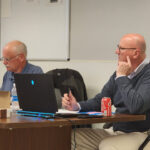One such building is the church on the corner of Military and Kelleran streets. This structure is quite different and unusual compared to other churches in the area.
To understand the construction of the building and learn who the architect was, we need to go back in time to May 17, 1902. This is the date of the “great fire” that destroyed many buildings in Houlton. A meeting held on May 19, 1902, provides the rationale for construction of this unique church. The proceedings of this stern and factual meeting were recorded by Harry L. Putnam, the Clerk of the Unitarian Church at that time.
“Our Church building was burned Saturday afternoon, May 17th. It was impossible to post any notice upon the church door, as required by the By-Laws, hence it was published in the Aroostook Pioneer Monday morning, May 19 in a special edition of that paper.”
This meeting and description made by church members initiated a rapid decision to build a new church. By May 23, 1902, a firm decision was made to construct a new church. After that decision, the chain of events was indeed rapid. By June 8th the church committee voted to purchase the Shaw lot that had burned at the corner of Kelleran and Military streets (current building site.) On July 23 the committee was formed to raise funds for the new church. Surprisingly, by June 28 the plan for the new church structure was submitted by Edwin J. Lewis, Jr., architect of Boston. The church committee quickly accepted the design submitted by architect, Mr. Lewis.
The work on the new church was completed and a meeting was held on Tuesday, Sept. 29, 1903. Dedication of the new church took place on Nov. 24, 1903. Over a space of just sixteen months the new building was ready.
At this point we need to explore the talents of architect Edwin L. Lewis, Jr. He was a highly respected architect in the Boston area. His father and mother (Edwin and Sarah Lewis) lived in Roxbury where Edwin L. Lewis, Jr. was born on May 1, 1859. Edwin had two sisters, Bertha and Marion. His father emigrated from England and was a pickle manufacturer. Edwin L. Lewis, Jr. attended the English High School and afterward graduated from the Massachusetts Institute of Technology in 1881 where he studied architecture. He apprenticed with Timothy Walsh for nine years at the respected architectural firm Peabody and Stearns.
Within six years of this, (1887), he was ambitious so he decided to start his own architecture business. He was very successful and designed no less than forty houses and commercial buildings. He was a lifelong resident of Dorchester and one of the most important architects in the Boston area. He designed thirty-five churches in the United States (including the one in Houlton) as well as in Canada.
One of his most famous buildings is the Peabody built 1896-97 in Dorchester. This is a massive apartment and professional building at Peabody Square. One church I like and which is similar to the one in Houlton, is the Wollaston Unitarian Church in Quincy, Massachusetts. As to the designs, some people state that many of his churches were based on the architectural designs from the medieval period in England.
Edwin Lewis, Jr. belonged to a number of professional organizations: The American Institute of Architecture, The Boston Society of Architects (he was secretary of this organization), The Boston Athenaeum and The Union Club.
We are fortunate in Houlton to have a building designed by this famous architect and we appreciate this historic church (it is on the National Register.) My advice is to sprint over to the Greater Houlton Chamber of Commerce office and pick up a copy of the Historic Downtown Walking Tour. Use this guide to enjoy the walking tour and add the Historic Unitarian Church to your walk. Better still, arrange with a Unitarian Church member to view the “Hidden Treasures” inside the church.






